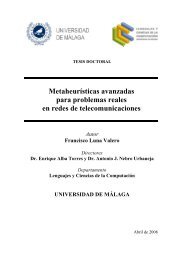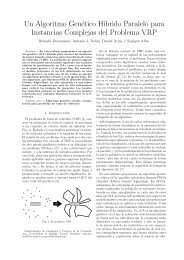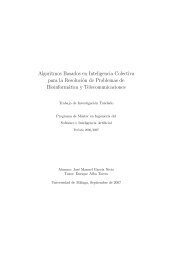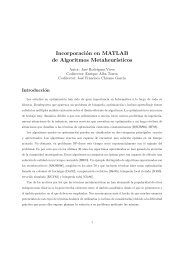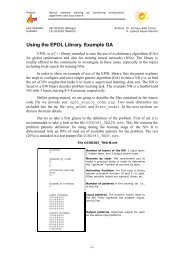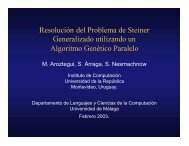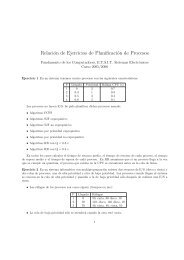Comparing Metaheuristic Algorithms for Error Detection in ... - NEO
Comparing Metaheuristic Algorithms for Error Detection in ... - NEO
Comparing Metaheuristic Algorithms for Error Detection in ... - NEO
You also want an ePaper? Increase the reach of your titles
YUMPU automatically turns print PDFs into web optimized ePapers that Google loves.
check<strong>in</strong>g? If some <strong>for</strong>m of abstraction can be used, then maybe. However they<br />
still require large amount of memory and they are not check<strong>in</strong>g the f<strong>in</strong>al implementation,<br />
so specific implementation details could still violate the properties<br />
checked be<strong>for</strong>e. However, fail<strong>in</strong>g to prove the model correctness does not mean<br />
they cannot be used to f<strong>in</strong>d errors. The mar problem is a good example of that.<br />
The search space could not be completely verified after us<strong>in</strong>g only 4 couples,<br />
but DFS was able to f<strong>in</strong>d errors even with 10 couples. The ability of DFS and<br />
BFS to f<strong>in</strong>d errors <strong>in</strong> large search spaces depends not so much on the size of the<br />
search space but more on its shape, as shown <strong>in</strong> the d<strong>in</strong> and mar tests.<br />
5.2 Length of the error trails<br />
The length of the error trail <strong>for</strong> each algorithm is also an important result that<br />
must be compared. S<strong>in</strong>ce the error trail is the <strong>in</strong><strong>for</strong>mation the developers have<br />
to debug the application, the more concise it is, the better. So, shorter error<br />
trails means that less irrelevant states exists <strong>in</strong> the trail, mak<strong>in</strong>g it easier <strong>for</strong><br />
the developer to focus on what leads to the errors As with the hit rate, exact<br />
algorithms always return the same error trail <strong>for</strong> each problem. Stochastic algorithms<br />
do not, so we present <strong>in</strong> Table 4 both the averages of the length of<br />
the first error trail found and of the shortest error trail length found <strong>in</strong> the 100<br />
executions. We <strong>in</strong>clude both of these values because the stochastic algorithms<br />
do not stop after an error has been found, but only after 200 000 states have<br />
been expanded, which means that more than one path to an error may be found<br />
dur<strong>in</strong>g the search.<br />
Table 4. Length of the error trails (first/shortest)<br />
Prob. DFS BFS A* GA GAMO PSO SA ACOhg RS BS<br />
phi 4 169 16 16 48/16 28/16 52/16 47/16 71/16 50/16 22<br />
phi 12 – – – 149/52 78/58 173/55 178/70 175/72 193/62 74<br />
phi 20 – – – 220/116 131/114 248/126 251/140 244/163 319/135 224<br />
phi 28 – – – 267/192 188/174 275/210 278/216 351/268 504/227 393<br />
phi 36 – – – 283/269 248/232 282/278 290/274 495/381 616/324 753<br />
d<strong>in</strong> 4 12 12 12 12/12 12/12 12/12 12/12 12/12 12/12 12<br />
d<strong>in</strong> 8 24 – – 24/24 24/24 24/24 24/24 24/24 24/24 24<br />
d<strong>in</strong> 12 36 – – 36/36 36/36 36/36 36/36 36/36 – 36<br />
d<strong>in</strong> 16 – – – 48/48 48/48 48/48 – 48/48 – 48<br />
d<strong>in</strong> 20 – – – 60/60 60/60 – – – – 60<br />
mar 2 14 12 12 13/12 13/12 13/12 12/12 13/12 12<br />
mar 4 63 26 28 42/27 39/27 43/27 45/29 42/28 44/29 36<br />
mar 6 140 – – 91/48 75/56 94/51 93/57 93/56 92/55 59<br />
mar 8 245 – – 148/77 108/94 154/79 149/91 152/92 151/88 172<br />
mar 10 378 – – 199/109 154/142 215/114 207/127 214/130 223/125 260<br />
giop 232 – – 251/238 252/247 263/236 264/243 256/242 284/239 355<br />
garp – – – 184/115 123/121 184/128 204/147 305/278 245/111 –






